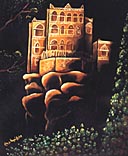
“Society Still Doesn’t Value Plastic Art” [Archives:1999/08/Last Page]
February 22 1999
Art is the soul of human life. It is the only language that can travel across distances and go beyond all barriers. Further, it can be understood by all people in the world. Artists have distinguished outlook to express the meaning of life. Plastic art is one of these arts that can reflect wide view of human life. This is why the world has given this kind of art a wide scope.

Q: Could you please tell us something about your arts interest?
A: Actually, my interest in plastic art and especially drawing started when I was child in the elementary school. I used to draw on the desks of my classroom. It was my primary hobby. Even after that in the university I kept on drawing. In my drawing I used coal and graphite. In fact, I feel indebted to my family, particularly my father, who helped polish my skill and pushed it forward.

A: For me, art is an influx of deep emotional feelings; its is a portrait through which the artist can express his inner feelings. He can embody these emotions in drawings which can be either real or imaginary. I draw pictures of the surrounding environment with all its beauties and incongruities, and also folkloric scenarios like the rural woman in her beautiful dress as well as the peasant and other spectacles embodying the struggling and challenging spirit of the rural people. The Yemeni environment is rich with many inspiring scenarios. Everything in this globe with its charms and contradictions inspires me to draw. These things can evoke the sense of any artist.

A: While studying in school, I participated in many school exhibitions in Taiz. I also participated in many activities in the university. I participated in the Arts First Gathering in Sanaa in 1996, which was attended by many Arab artists. My portraits were among these admired by many attendants. Another participation was on the From Child to Child Festival in 1998 in Taiz.
Q: How do you see the plastic art drive in Yemen?
A: Artists are found all over the country. Unfortunately, they are lacking the needed support and drive. This is what is happening to us here in Taiz. Some people intend to dishearten us. They are also working against the founding of any society for the plastic artists of Taiz. The Ministry of Culture should understand the importance of this art and its role in highlighting the originality of our cultural heritage. The society should also help encouraging the artists through holding and attending the exhibitions of our artists. Unfortunately, many people in our society still don’t understand what plastic art is.
Q: Any last word?
A: Finally, I would like to thank the Yemen Times, its chief Editor Dr. Abdulaziz al-Saqqaf, the voice of Yemen inside and outside Yemen and all the working staff of the paper. Also, I would like to call all the plastic artists of Yemen not to stop and to explore new avenues in the world of this kind of art for it is only man that makes the history. It is expected that some young artists will apply for the membership in the Yemeni Plastic Artists Syndicate in Sanaa, and we will open a branch for it here in Taiz.
——
[archive-e:08-v:1999-y:1999-d:1999-02-22-p:./1999/iss08/lastpage.htm]


